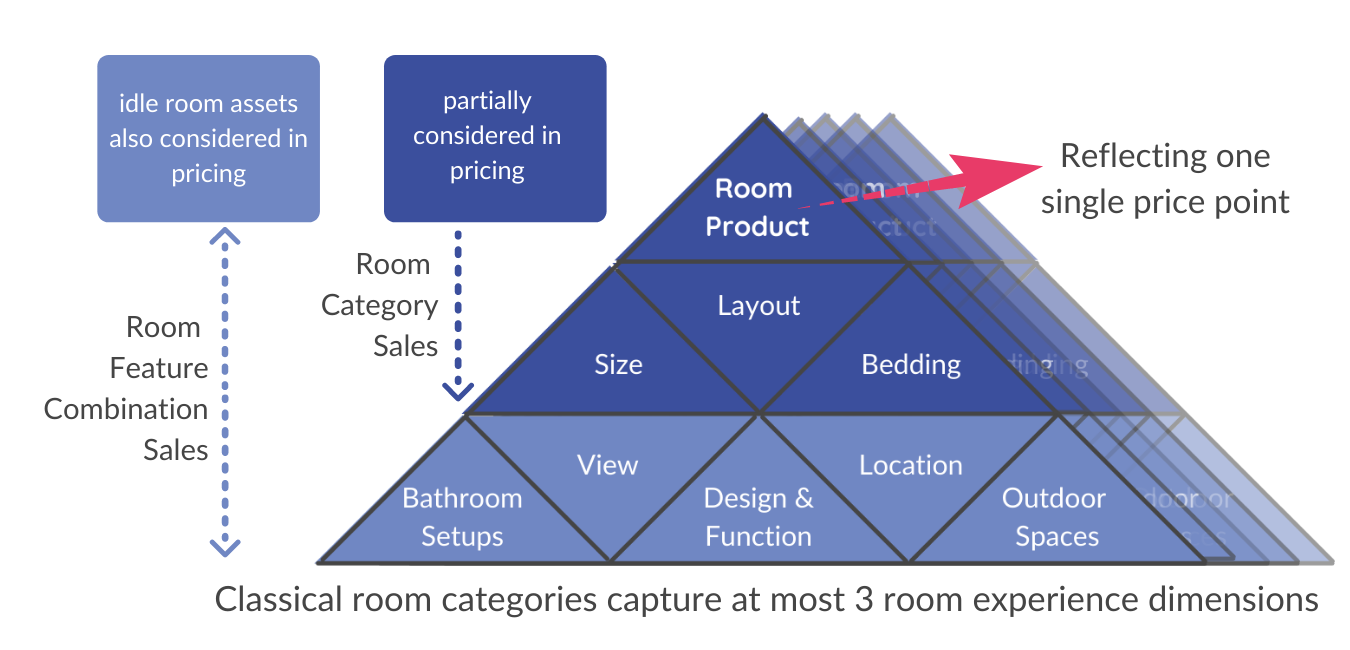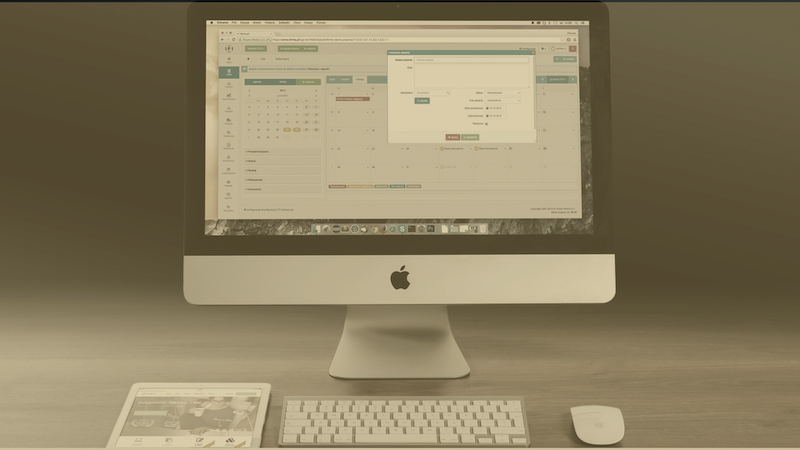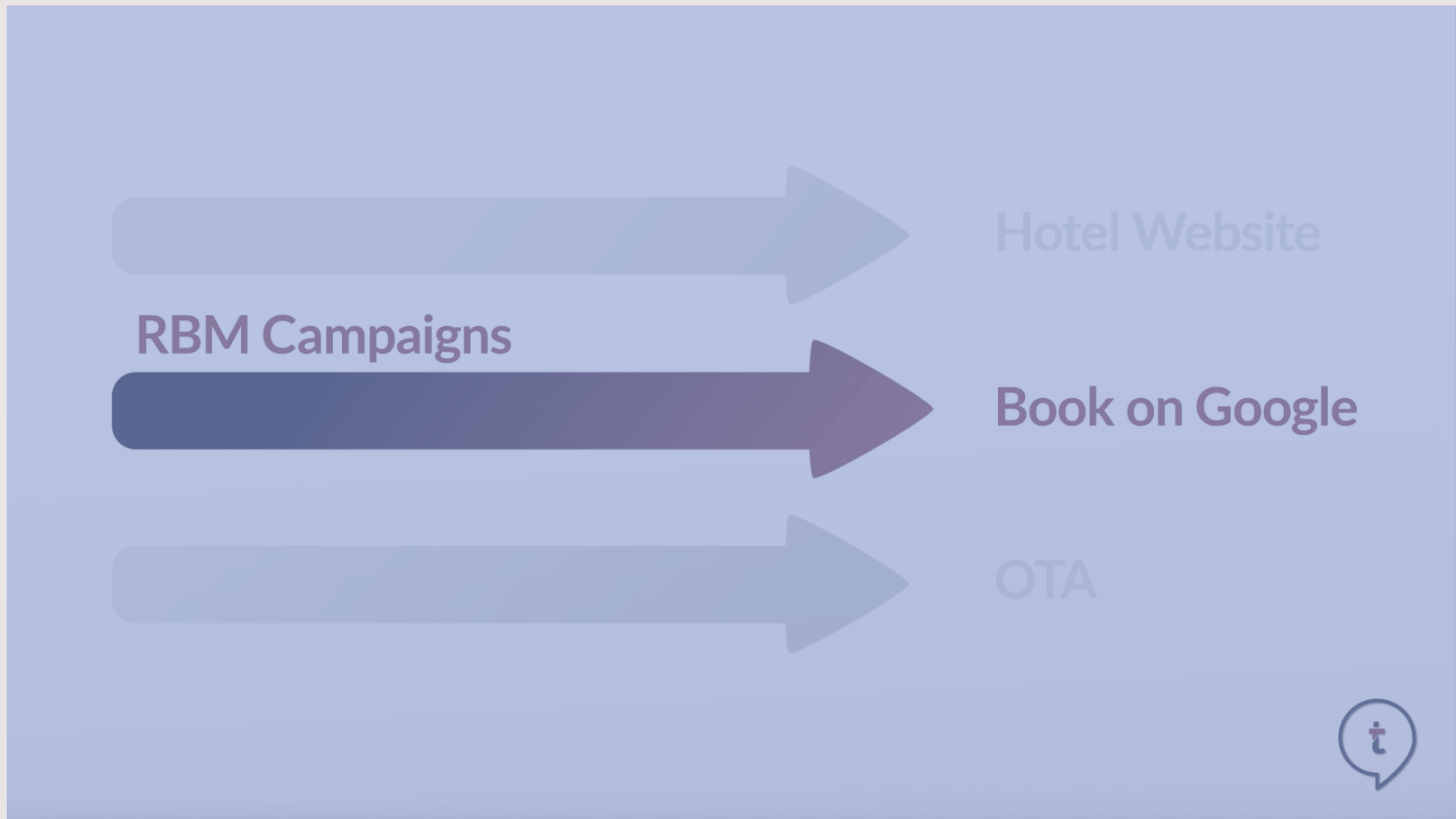Winning back control. What can happen if you break away from room categories and manage hotel inventory in room feature clusters?
Hotel and accommodation operators are used to the fact that they need to simplify and reduce their room inventory to some manageable room clusters and categories. Those rooms categories are priced and distributed through all possible sales channels subject to the hotel’s
technology stack and distribution capabilities.
However, this approach is not maximizing the return on the real estate asset and has many downsides, which have unfortunately become an acceptable practice in our industry today. Just to highlight three:
Three downsides of room categories
- In the absence of global room or hotel quality standards, guests go through a room gamble approach when making reservations. What is a standard room? What is a deluxe room? And if guests want to book a connecting room, they cannot do it online. Latest trends, such as consumers expecting a high degree of personalization, cannot be accommodated, and if personalization is possible, then only with endless emails or actual phone calls. This limits the hotel from automating its operational processes and increases labor costs. The standard operational procedure is still to assign rooms for each reservation before the guest's arrival manually.
- Another example is that due to the simplification of the room product, rooms have become a commodity. Aggregators used this to their benefit, making any hotel rooms very comparable. Therefore and due to the lack of other differentiating factors, it is no surprise that hotel companies use tactics and tools like best price guarantees, etc., to drive direct bookings. However, this battle has been widely lost to online aggregators who do a much better job at selling room inventory than the hotels selling room inventory directly.
- A third challenge today is that due to the internet making all products easily comparable, hotels had to streamline their sales strategies for all geographic markets. However, subject to the guest feeder market, different competitors or price sensitivities apply besides different travel patterns or infrastructure access. So, it can be very viable and effective selling differently to different markets. Two decades ago, prior to the internet booking era, this was not an uncommon strategy for hotels to maximise their business share from different markets, but today, this is challenging to execute.
So why is it possible that humans are executing missions to Mars, but the hospitality industry cannot automate room assignments, optimize room products by sales channel, or confirm personalized room matches based on customer needs? A legacy mindset from the 1960s, protectionism from legacy systems, and the way room inventory is managed in hospitality technology are undoubtedly part of the problem as we did not
question the setup when starting to sell online.
Standardization, simplification, and hotel inventory generalization were the result of providing digestible inventory to online platforms! The only way of selling the inventory in its unique way is through direct sales by phone and email - for this; however, one needs good, qualified staff
that is familiar with the hotel’s inventory and eager to upsell in the best interest of the hotel (and guest) – a high human dependency.
What if you could keep a digestible and straightforward approach to your inventory but also be able to place all your unique room assets on the shelf for your guests and monetize these as demand patterns for those features prove their value?
Since hotel products have been widely commoditized, creating a sea of sameness, only a strong brand recognition and quality standards justify higher room rates than the competitor property next door.
Not every hotel operator has strong brand power – but every independent hotel should have the power to show its room individuality and its true differentiators.
A different hotel inventory management
Today's technology opens the door for different inventory management, for new horizons, and no limitations that keep us away from differentiating our product and stand out from the competition. Even if third-party distribution channels are standardizing how hotel inventory is being sold, own (direct) channels could be completely differentiated and personalized and therefore drive the book direct agenda!
Our industry must fundamentally change the way room inventory is managed, controlled, priced, and sold to gain back market share from third-party providers.
As hoteliers, we need to remind ourselves that the core value contribution in the travel value chain is our room inventory. Therefore, breaking away from how inventory is managed traditionally is a pivotal component to improve market power and operating margins for hoteliers.
A new room codification approach as a basis for new selling concepts!
What if you could carefully review your room inventory and digitalize all relevant features of the room experience that differentiate one room from the other? We suggest categorizing room features into layout, bedding, space, location, view, bathroom setup, outdoor space, and design & functional elements for easier data management.
Rooms can then be clustered into much more granular Room Feature Combinations (RFC). Unfortunately, this also suggests that there is sometimes only one or a few physical rooms in the same Room Feature Combination.
This way of managing room inventory creates many more data points and potential price points, allowing for better guest needs matches. Finally, you can now think about all the guest reviews and all the "room tips" and feedback you have received so far that you could never really do anything about.
You might think, how can so many new room products (Room Feature Combinations) be managed and distributed? This is where new technology now available in the market is required, using Artificial Intelligence (AI) and Machine Learning (ML) to optimize your property's sales and inventory management approach.

What is the upside of the Room Feature Combination approach?
- The room names for your Room Feature Combinations can reflect true differentiators – finally, your room description makes sense. It is not linked to an artificial or generic description with no meaning!
- You can act on guest reviews that refer to room preferences, features, and recommendations.
- You can monetize features you have been hiding in the past.
- Guests can select their rooms based on their preferences.
- You can differentiate your inventory from third party channels.
- You can take an individual sales approach per user group.
What does new technology do to ensure a smooth distribution?
The first thing that new technology needs to provide is a new booking experience to allow guests to personalize their room experience without being overwhelmed. At the same time, it provides enough relevant products for the guests’ stay on the retail shelf. The new approach also requires a new way of revenue management, adding the capability of repackaging room inventory and optimizing it for third-party channels, managing the respective limitations of each channel.
This provides a competitive advantage for hotel operators since they can now sell something no other channels can sell and have no limitation in personalizing booking experiences for their own sales channels. In addition, this changes the discussion about rate parity again since its room products are not comparable anymore.
How can you compare a price point across different room products with different room features? It’s like comparing the prices of two different sneaker designs - impossible!
Of course, you will have to invest some initial time to review your strategy that you have focused on until today. Review your current technology stack to identify if your current systems allow you to sell what you truly can sell. Reflect on your entire inventory and every idle room asset valued by your guests and ensure your product is adequately codified and reflected in all relevant sales channels.
By changing the way room inventory is managed, priced, and sold, a hotelier can win back control and gain a competitive advantage, finally selling all unique room experiences directly. New and more data points allow a better matching process during the reservation process for the guests and incentivize guests to book direct, offering true personalization options. Just imagine how loyalty programs could be improved with such granular room inventory data. As a result, a feature-based inventory management approach increases your revenue and guest satisfaction.
Summarising the benefits of a feature-based sales approach
Using latest technology solutions will help hoteliers to:
- More price points for the buyer leading to higher conversion
- Upselling higher value room products leading to higher revenues
- Enable clear product differentiation for higher brand awareness and more direct bookings
- Provide a better guest experience through automated and tailored room assignments, leading to higher satisfaction, better guest reviews, and more returning guests
About the author
Markus Müller, Co-Founder at GauVendi

Markus is the Co-Founder of GauVendi, the Intelligent Feature-Based Hospitality System. With over 25 years of experience in the tourism industry, Markus lived most of his career in Asia, the Middle East, Eastern Europe, and the Caribbean. His last positions included Global VP Sales & Marketing at WorldHotels, Regional VP Sales & Marketing at Moevenpick Asia, and various senior positions with IHG Intercontinental Hotels Group.
Connect with Markus on Linkedin.
Related Resources
- ARTICLE l Attribute Based Selling (ABS), What is it? by Erik Tengen, Co-Founder at Oaky
- ARTICLE by Kristie Goshow, CMO at Preferred Hotels & Resorts l Demand Generation - The Pivot. A Human-first Value Strategy
- PODCAST l Discussing Attribute-based Pricing with Janel Clark, when with Snapshot; Stefan Gerster from pentahotels and Pontus Berner from berner+becker, hosted by André Baljeu
- INFOGRAPHIC l Modern Demand Generation using Attribute Based Selling
- VIDEO l Demand Generation
- EDITORIAL l Internet Booking Engines (IBEs) & Direct Distribution in Hospitality
To all techtalk.travel editorials.
More Perspectives on the Concept of Attribute-based Selling
Here you can watch the video interviews with the Panelist discussing Attribute Based Selling at the HEDNA Global Distribution Conference 2020 in Los Angeles.





![V03: The History of Hotel & Travel Technology | [Updated] Infographic](https://www.techtalk.travel/storage/app/uploads/public/63f/e6f/ec8/63fe6fec80447817849943.jpg)



Create an account to access the content.
Get access to Articles, Video's, Podcasts, Think Tanks, Infographics and more.
Click “Sign In” to accept our
Terms of Service Privacy Policy